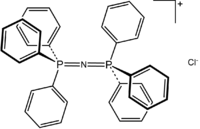µ-nitrido-bis (triphenylphosphine) chloride
| Structural formula | ||||||||||||||||
|---|---|---|---|---|---|---|---|---|---|---|---|---|---|---|---|---|

|
||||||||||||||||
| General | ||||||||||||||||
| Surname | µ-nitrido-bis (triphenylphosphine) chloride | |||||||||||||||
| other names |
|
|||||||||||||||
| Molecular formula | C 36 H 30 ClNP 2 | |||||||||||||||
| Brief description |
beige powder |
|||||||||||||||
| External identifiers / databases | ||||||||||||||||
|
||||||||||||||||
| properties | ||||||||||||||||
| Molar mass | 574.03 g · mol -1 | |||||||||||||||
| Physical state |
firmly |
|||||||||||||||
| Melting point |
273-274 ° C |
|||||||||||||||
| safety instructions | ||||||||||||||||
|
||||||||||||||||
| As far as possible and customary, SI units are used. Unless otherwise noted, the data given apply to standard conditions . | ||||||||||||||||
µ-Nitrido-bis (triphenylphosphine) chloride is a chemical substance with the empirical formula [((C 6 H 5 ) 3 P) 2 N] Cl, which is often abbreviated as PPNCl. The colorless salt is a source of [PPN] + - cation to otherwise difficult, which is used anions crystallize. [PPN] + is a phosphazene .
Manufacturing
The representation of PPNCl takes place in two steps from triphenylphosphane :
The resulting triphenylphosphine dichloride is a chlorination reaction used in organic chemistry , which is present as an ion pair in polar solvents and as a trigonal bipyramidal molecule in non-polar solvents . Further treatment with hydroxylamine in the presence of an equivalent of Ph 3 P results in the replacement of the P-Cl bonds with P = N bonds:
application
PPN chloride is the most important precursor for other [PPN] + salts. Nitrites , azides and other small inorganic anions with [PPN] + as a cation can be obtained by displacement reactions . These salts are soluble in polar organic solvents. [PPN] + salts enable the crystallization of compounds with anions whose metal salts would be unstable in the solid phase .
Individual evidence
- ↑ a b c data sheet bis (triphenylphosphoranylidene) ammonium chloride from Sigma-Aldrich , accessed on October 18, 2016 ( PDF ).
- ↑ a b A. Martinsen, J. Songstad: Preparation and Properties of Some Bis (triphenylphosphine) -iminium Salts, [(Ph 3 P) 2 N] X . In: Acta Chemica Scandinavica . A31, 1977, p. 645-650 .
- ↑ JK Ruff, WJ Schlientz: μ-nitrido-Bis (triphenylphosphorus) (1+) (“PPN”) Salts with Metal Carbonyl Anions . In: Inorganic Syntheses . tape XV , 1974, p. 84-90 .
- ↑ e-EROS Encyclopedia of Reagents for Organic Synthesis, doi : 10.1002 / 047084289X.rt371
- ↑ SM Godfrey, CA McAuliffe, RG Pritchard, JM Sheffield: An X-ray crystallorgraphic study of the reagent Ph 3 PCl 2 ; not charge-transfer, R 3 P – Cl – Cl, trigonal bipyramidal or [R 3 PCl] Cl but an unusual dinuclear ionic species, [Ph 3 PCl + ... Cl - ... + CIPPH 3 ] Cl containing long Cl –Cl contacts . In: Chemical Communications . 1996, p. 2521-2522 , doi : 10.1039 / CC9960002521 .
- ↑ SM Godfrey, CA McAuliffe, JM Sheffield: Structural dependence of the reagent Ph 3 PCl 2 on the nature of the solvent, both in the solid state and in solution; X-ray crystal structure of trigonal bipyramidal Ph 3 PCl 2 , the first structurally characterized five-coordinate R 3 PCl 2 compound. In: Chemical Communications . 1998, p. 921-922 , doi : 10.1039 / a800820e .
- ^ JK Ruff: Chemistry of the dinuclear carbonyl anions. II. Mixed-metal derivatives . In: Inorganic Chemistry . tape 7 , 1968, p. 1818-1821 , doi : 10.1021 / ic50067a023 .
- ↑ LB Handy, JK Ruff, LF Dahl: Structural characterization of the dinuclear metal carbonyl anions [M 2 (CO) 10 ] 2 - (M = chromium, molybdenum) and [Cr 2 (CO) 10 H] - . Marked stereochemical effect of a linearly protonated metal-metal bond. In: Inorganic Chemistry . tape 92 , 1970, pp. 7312-7326 , doi : 10.1021 / ja00728a014 .



![{\ displaystyle \ mathrm {\ rightarrow [(Ph_ {3} P) _ {2} N] Cl \ + \ 4 \ HCl \ + \ Ph_ {3} PO}}](https://wikimedia.org/api/rest_v1/media/math/render/svg/7a7bbfd706c8030f117a5c4e245f2897e24c2ba3)